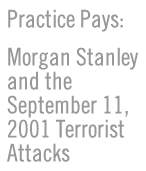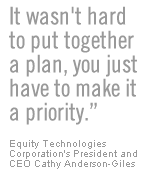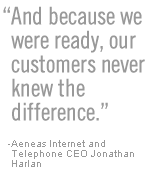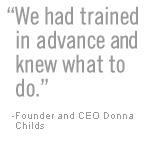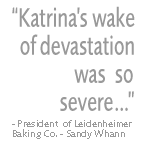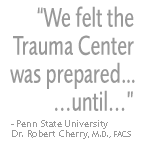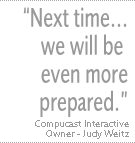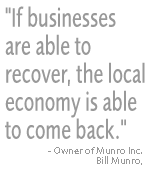Morgan Stanley | Equity Technologies | Aeneas | Childs Capital, LLC | Leidenheimer Baking | Penn State | John Deere | Compucast Interactive | Munro Inc.
Morgan Stanley
In 1993, when terrorists attacked the World Trade Center for the first time, financial services company Morgan Stanley learned a life-saving lesson. It took the company 4 hours that day to evacuate its employees, some of whom had to walk down 60 or more flights of stairs to safety. While none of Morgan Stanley's employees were killed in the attack, the company's management decided its disaster plan just wasn't good enough.
Morgan Stanley took a close look at its operation, analyzed the potential disaster risk and developed a multi-faceted disaster plan. Perhaps just as importantly, it practiced the plan frequently to provide for employee safety in the event of another disaster.
On September 11, 2001, the planning and practice paid off. Immediately after the first hijacked plane struck One World Trade Center, Morgan Stanley security executives ordered the company's 3800 employees to evacuate from World Trade Center buildings, Two and Five. This time, it took them just 45 minutes to get out to safety!
The crisis management did not stop at that point, however. Morgan Stanley offered grief counseling to workers and increased its security presence. It also used effective communications strategies to provide timely, appropriate information to management and employees, investors and clients, and regulators and the media.
Morgan Stanley still lost 13 people on September 11th, but many more could have died if the company had not had a solid disaster plan that was practiced over and over again. In making a commitment to prepare its most valuable asset, its people, Morgan Stanley ensured the firm's future.
back to the topEquity Technologies
Equity Technologies Corporation knows what it means to be prepared. Located in Mobile, Alabama, the company has long had plans and procedures in place to counter the threat posed by hurricanes and other severe weather. For instance, Equity Technologies promotes family and individual preparedness and has set up a means of communicating with employees when dangerous weather threatens. Employees carry laminated cards with contact information for supervisors and a voice recorded call-in number with updates about the company's status.
But it was the risk of Y2K related disturbances that motivated Equity Technologies to get serious about its disaster preparedness and business continuity plans. "We are a small company which does business around the world. To be competitive my clients must feel confident that we are ready for anything," said Equity Technologies Corporation's President and CEO Cathy Anderson-Giles. "It wasn't hard to put together a plan, you just have to make it a priority."
First the company identified workers to serve as key contacts for the 72-employee operation. These key contacts then established safety and security teams which analyzed Equity Technologies Corporation's entire emergency process.
The teams realized that communication between the company and the outside world was the single most important operational factor in an emergency. As a result, Equity Technologies purchased generators to power the phone system during utility outages and trained co-workers to set them up within seven minutes. Not only does the company have emergency plans and procedures in place, it has made a commitment to review the plans and tools each year at the start of the hurricane season. "We have the annual review on our corporate calendar," said Anderson-Giles. "Being prepared means being ready for any kind of emergency, be it hurricane, utility disruption or man-made disaster."
back to the topAeneas
The people who work at Aeneas Internet and Telephone of Jackson, Tennessee, know what it's like to have their business devastated by Mother Nature. Fortunately, because they had a disaster recovery plan, they also know what it's like to recover from devastation.
On May 4, 2003, Aeneas was among the more than 400 businesses in Tennessee hit by an F4 tornado, packing winds greater than 200 miles per hour. The tornado resulted in eleven deaths and more than $50 million in damage throughout the community. Aeneas Internet and Telephone lost more than $1 million in hardware and software, and its home office was reduced to rubble.
"There was nothing left of our building. Just piles of bricks and concrete. We lost everything," said Aeneas Internet and Telephone CEO Jonathan Harlan. "But back-up systems were in place and our employees worked from other locations. And because we were ready, our customers never knew the difference."
Less than 72 hours later Aeneas was back, fully serving its clients' needs. In fact, many of its smaller business and residential phone customers never lost their service. Aeneas had been able to protect itself against a worst-case scenario because it had planned for a worst-case scenario. Its business recovery plan was based on the idea that even if its facilities were destroyed and services halted, it would have back-ups in place and ready to go.
Through the recovery effort, Aeneas officials were careful to keep customers abreast of their progress. Aeneas also benefited from the quick work and dynamic spirit of its employees and the local community who refused to let a tornado bring down what they had fought so hard to build in the first place.
back to the topChilds Capital, LLC
Many small businesses struggled to recover after the terrorist attacks of September 11th, but one small company with a comprehensive contingency plan was back in business within a week.
Childs Capital, LLC, a company that specializes in international economic development, is located very near Ground Zero. The company's chief executive officer was in the World Trade Center when the first plane hit. "I immediately called the office and told them that it wasn't safe, then ordered an evacuation and initiated our emergency plan," said Childs Capital Founder
and CEO Donna Childs. "We had trained in advance and knew what to do."
As the dust settled, Childs Capital still had to cope with major disruptions to power, telephone, water and other utilities. "Our building had a back-up generator that allowed us to run some of the computers, but we had planned to rely on battery-powered laptops," said Childs. Childs Capital was back in business, albeit in a limited capacity, within a week.
It took the company less than a month to get back to full operation. "I used to be in the reinsurance business and I knew exactly how to document the expenses we were incurring," said Childs. "Our insurance company paid in full in three days of submission and we were back in business."
back to the topLeidenheimer Baking Company
Sandy Whann is the current president of the family owned-and-operated Leidenheimer Baking Company. He is the fourth generation of Leidenheimer men to run the company which was founded in 1896 in the city of New Orleans by Sandy’s great-grandfather, George Leidenheimer of Germany. The bakery produces French bread made famous by traditional local dishes like the muffaletta and po boy sandwiches that originated in the heart of the French Quarter.
As a lifetime citizen of New Orleans, Sandy has experienced many evacuations and has become adept at hurricane planning through the years. When the hurricane alert was issued on Saturday, August 27, 2005 this veteran immediately put his family emergency plan into effect as his wife and two children prepared to leave the city. Sandy remained near the plant to keep a close eye on his 110-year-old company and keep production working at a minimal capacity. With his family out of the city, Sandy now focused on his employees and their families.
On Sunday, after meeting with his upper management, Sandy uncharacteristically decided to shut the bakery down, secure its exterior, gas lines and doors and encouraged his employees to prepare their own homes and loved ones for the storm and potential evacuation. Both Sandy and the Leidenheimer management team keep home phone numbers and emergency evacuation contact information for all employees. After most of his employees had left, only Sandy, his plant manager, and chief engineer, all of whom play key roles in the business’s preparedness plan, remained in New Orleans.
Once Sandy and the others had completed their assigned duties in the emergency shutdown, they left as well. While driving to meet with his family in Baton Rouge, Sandy was struck by the unusualness of the event, particularly because the drive which normally takes one hour took seven hours.
"Things were very different this time around," said Sandy. "But in the gridlock I still made the most of the little time we had before the storm hit. Having an emergency preparedness plan helps you focus your priorities and helps you know what you need to be doing with the limited time you have in any situation."
En route, Sandy checked with his insurance provider, accountants, legal consultant, and spoke with customers via cell phone to keep them abreast of the situation and the affect of his shutdown on their supply of baked goods. Sandy’s business evacuation kit played a large part in his success. Sandy’s kit included: financial and payroll records, utility contact information, updated phone lists for his customers and employees, back-up files and software, as well as computer hard drives. Well before the evacuation Sandy placed the kit in a mobile waterproof/fireproof case that could be taken with him at a moment’s notice. As part of Sandy’s written plan, he set-up a satellite office for the Leidenheimer Baking Company in Baton Rouge where he made contact with his bank, forwarded phone lines, and was receiving forwarded mail within two days after the evacuation.
On August 29, Sandy breathed a sigh of relief that his family and his company had escaped a major disaster. He and his leadership team had high hopes of getting production up and running, but had no luck in finding out the status of their facility. Once they received word of extensive flooding in New Orleans, Sandy’s anxiety as a business-owner really started to set in.
Water in the plant was the worst problem, from a business standpoint, says Sandy. "My first instinct was to return and help with recovery, repair damages and get home. But this was impossible because Katrina’s wake of devastation was so severe."
Fortunately, Sandy was able to return to his plant within a week of the storm hitting. When he returned, he was met with widespread damage, but without the flooding he had expected. In the facility, thousands of pounds of melted yeast and other ingredients had been sitting wet for weeks without refrigeration. The roof had severe damage, there was no power, no usable water, and no one was permitted back into the city except the National Guard. The plant was 120 degrees with foul smells emanating from every square inch. All Sandy could focus on was getting the plant back into production as soon as possible.
Despite caring deeply for his business, the most important thing to Sandy was his employees and he felt fortunate that all of the company’s employees were safe. He arranged a carpool service to pick up employees at shelters to drive them to work and back each night. Sandy tried to remain supportive of his employees while still staying open for business.
"The rebuilding process included a handful of things," said Sandy. "Number one is the employees. What some of our folks faced and what they are still facing in their personal lives is heart-breaking. It is important to listen to the needs of employees." Sandy expresses.
In summing up his experience Sandy said, "Katrina was severe enough to teach even us experienced hurricane survivors a few new things about our emergency planning." Since Hurricane Katrina, Sandy has revised his business emergency plan and gained a more extensive understanding of the importance of preparation.
back to the topPenn State University - Dr. Robert Cherry, M.D., FACS
"Whether you are a public health official or a business leader preparing to manage a natural disaster or a threat scenario, always realize you may encounter situations and circumstances that challenge the best plans," says Dr. Robert Cherry, Medical Director of the Penn State Shock Trauma Center.
Dr. Cherry learned this lesson first-hand working as Director of a level-one trauma center in the New York City area on Sept. 11, 2001. The doctor now realizes that each day brings unexpected challenges caused by constantly shifting circumstances. Like many New Yorkers on that day, he found the surreal experience tested even the most rehearsed plans.
"We felt the trauma center was prepared for disasters, until we found things that we simply hadn't planned for," said Dr. Cherry. "We had generators for power, but what if we needed them and exhausted our 36 hours of fuel reserve? Did we have a way of refueling?"
While dealing with the aftermath of 9/11, Dr. Cherry and his team faced the reality of not being prepared for a disaster of this magnitude. Like many other hospitals in New York City, they were concerned about the limited number of resources, including staff, equipment, and communications technology, and what is actually needed to adequately plan for and manage a large disaster. Dr. Cherry’s experiences that day deeply impacted his life and later inspired him to develop a Homeland Security program at Penn State’s Medical Center.
"The program teaches students the skills that allow them to be flexible, adaptive and responsive to whatever situation arises during an emergency," added Dr. Cherry. "Cultivating this culture among leaders in medicine or any business will greatly increase the security of the facilities and the employees that are required to survive a disaster and eventually allow an organization to return to normal productivity."
In January 2006, Penn State College of Medicine began this new program, making it one of the first medical schools in the United States to offer a master's degree program in Homeland Security. Dr. Cherry, now serving as the lead faculty member of Penn State's World Campus Master of Homeland Security and Public Health Preparedness, is already planning additional programs that will prepare the leaders of the future.
"You have to adopt an emergency plan that allows for change because it is impossible to adapt an inflexible plan during an emergency situation," said Dr. Cherry. "Whether in medicine or business, I encourage everyone to establish emergency preparedness plans that allow your people to adjust to any situation that comes your way. This skill is learned through training, knowledge of the plans and practice."
back to the topJohn Deere Worldwide Security/Aviation
"Safety and security of employees has always been a major priority for our company," stated Allen Steinbeck, Director of John Deere Worldwide Security/Aviation.
One of the oldest manufacturing companies in the United States, John Deere, is making emergency preparedness a company priority. As a member of the team that created the National Fire Protection Association’s (NFPA) 1600 Standard on Disaster/Emergency Management and Business Continuity, Steinbeck is using this knowledge to develop and implement best practices within John Deere.
"Planning for critical incidents and training employees on proper emergency procedures should become a standard throughout any business model," said Steinbeck. "The NFPA 1600 Standard was instrumental in helping our security team identify the specific areas where our emergency plans needed to be enhanced."
John Deere Worldwide Security has employed Regional Security Managers working with an Emergency Preparedness Manager (EPM) to ensure that all units have comprehensive and updated emergency action procedures that adhere to the Corporate Crisis Management Plan and the NFPA 1600 Standards. The EPM is responsible for all emergency training, initiating a Pandemic Plan, identifying and implementing best-practices, acquiring technology to deal with critical incidents, and various other emergency preparedness duties.
"Extensive planning, preparation and training are the key elements for effective mitigation of an actual or threatened crisis. Every company regardless of size needs to become well-versed on the NFPA 1600 Standards and remain diligent in implementing the appropriate plan for their circumstances throughout their structure," concluded Steinbeck.
back to the topCompucast Interactive
New Orleans-based Compucast Interactive is thankful that they had an emergency plan in place, especially when Hurricane Katrina blew through the city in August of 2005. As a Web services company for more than 250 New Orleans businesses, it was paramount for those businesses and their thousands of employees to have the ability to continue making announcements and sending e-mails to their colleagues and customers.
Prior to Katrina, Compucast had secured dedicated servers outside of New Orleans in San Francisco and Philadelphia in the event of severe weather or any other emergency, specifically a hurricane. Judy Weitz, owner of Compucast, said, "With the business now located in two cities on opposite sides of the country, we were confident all Web sites would continue to function if a hurricane were to hit New Orleans."
When Katrina was forecasted, Judy made arrangements for a pet-friendly hotel with high-speed Internet access, so work could continue and so she could evacuate her whole family, including her three dogs. By Saturday evening, when the worst of the storm was impending, Judy packed all computers and equipment and left with her family for Houston.
As soon as she checked into the hotel and set up the new "office", Compucast was immediately able to reach several clients. As one of the very few Web site providers able to keep in touch with their clients, they were soon spending each day updating Web sites and helping businesses reach out to their employees who had been scattered throughout the United States. "All e-mail addresses remained fully functional for all our clients, which was so important during that critical time," said Judy.
Due to its emergency planning, Compucast became a hub of activity. The Internet became one of the only ways to keep in touch and both employers and employees were searching for each other online. Employees who were stranded were able to find a place to stay and employers were able to announce to their employees all arrangements being made for them, i.e., where to send paychecks, when they planned to re-open, etc. The ability for employees and employers to keep in touch allowed many businesses to begin the rebuilding process.
For local non-profit associations, Compucast set up mailing lists to reach out to members who had been dispersed to different cities and contacted authorities when they heard of anyone who was still stranded.
Shortly after Katrina devastated much of the New Orleans area, news organizations contacted Compucast because they were one of only a few local Web site providers still online. Compucast was able to put the media in touch with businesses that had been severely affected so they could cover rebuilding efforts. Compucast also created a free job search site to help businesses and potential employees find each other.
"We are thankful we were able to play even a small role in helping people during this time," said Judy. "Next time around, we will be even more prepared, as we have replaced all of our desktop computers with laptops! We will now have room in the same car for our family and pets and our customers' lifeline communication resources."
back to the topMunro Inc.
Bill Munro, owner of a dry cleaning, uniform rental and safety apparel business, thought he was prepared for anything with his basic emergency plan. However, when Hurricane Rita struck his community, Bill, third-generation owner of Munro Inc., was surprised to learn that his plan was outdated and left a lot of room for improvement.
Originally, Hurricane Rita was not forecasted to come near his hometown of Beaumont, TX. In fact, it was supposed to hit down the coast about 150 miles. But, the weather pattern made a fast change and Hurricane Rita came charging straight through the Beaumont area. The entire community was forced to evacuate, which meant the Munro employees were dispersed across several states.
"Our plan had not been updated in years and had just deteriorated, but we were fortunate to have a communications plan which was basically a cell phone network that connected all of our employees," said Bill. "This was vital because we were spread out across the region during the evacuation."
Though Bill had a rudimentary emergency plan in place, it did not account for power loss or for the shortage of food and supplies after the hurricane. It took Bill a week to reopen his business. However, he discovered there wasn't much of a need for dry cleaning among his customers. There was, on the other hand, a huge need for a laundry service in the community. Local contractors needed clean clothes, so Munro stepped up to fill this demand with a wash, dry, and fold service.
Though many of his employees had made their way back into the community and were ready to come back to work, schools had not reopened yet so they needed a place where their children could be supervised. To solve this issue, Bill allowed his employees to bring their kids to work. Some of the kids pitched in and worked, while others played in a conference room that was converted into a kid-friendly area complete with videogames and toys.
"Though we had a basic emergency plan in place and were fortunate enough to reopen relatively quickly, we knew we could do a lot better," said Bill.
After Hurricane Rita, Bill immediately took additional steps to be better prepared for the future. As a result, Bill drafted a plan to board up and secure buildings prior to evacuation and created a more in-depth communication program that requires employees to contact their supervisors within 48-hours to let them know their location and a phone number where they can be reached. In addition, he stocked-piled supplies including bedding and linens, hygiene products and enough food to feed 15 key employees for up to three and a half days. Those key employees, who are critical to getting the business back up-and-running, have been identified and notified, and Bill has worked with local authorities to get them clearance to return to the area early.
Additionally, Bill has installed showers and a natural-gas generator. He also contacted his power provider to arrange for his utilities to be turned back on within 48-hours of an incident.
"I can't imagine any business moving forward without a plan. If businesses are up and running, individuals can receive a paycheck and the community can stabilize," concluded Bill. "If businesses are able to recover, the local economy is able to come back. It's so critical."
back to the topThis is not intended to constitute an endorsement by DHS of these companies or their products.






